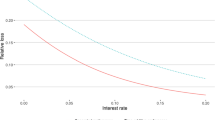Abstract
The level of need and costs of obtaining long-term care (LTC) during retired life require that planning for it is an integral part of retirement planning. In this paper, we divide retirement planning into two phases, pre-retirement and post-retirement. On the basis of four interrelated models for health evolution, wealth evolution, LTC insurance premium and coverage, and LTC cost structure, a framework for optimal LTC insurance purchase decisions in the pre-retirement phase is developed. Optimal decisions are obtained by developing a trade-off between post-retirement LTC costs and LTC insurance premiums and coverage. Two-way branching models are used to model stochastic health events and asset returns. The resulting optimization problem is formulated as a dynamic programming problem. We compare the optimal decision under two insurance purchase scenarios: one assumes that insurance is purchased for good and other assumes it may be purchased, relinquished and re-purchased. Sensitivity analysis is performed for the retirement age.
Similar content being viewed by others
References
AHCA, Consumer information-about long-term care, http://www. longtermcareliving.com/ (2003).
K.H. Arrow, Uncertainty and the welfare economics of medical care, American Economics Review 53 (1963) 941–973.
L. Barrett, The costs of long-term care: Public perceptions versus reality-executive summary, http://research.aarp.org/health/ltc_costs_1. html (AARP, December 2001).
J.A. Beekman, An alternative premium calculation methoded for certain long-term care coverages, Actuarial Research Clearing House 2 (1989) 39–61.
J.R. Birge, Stochastic programming computation and applications, INFORMS Journal of Computing 9(2) 1997) 111–133.
Z. Bodie, R.C. Merton and W.F. Samuelson, Labor supply flexibility and portfolio choice in life-cycle mode, Economics Dynamics and Control 16 (1992) 427–449.
J.Y. Campbell and L.M. Viciera, Consumption and portfolio decisions when expected return are time varying, NBERWorking paper No. 5857 (1996).
D.A. Collett, C.L. Austin and J.W. White, Long-term care insurance: A rapidly growing, little understood product, Best Week-Life/Health Supplement 7 (October 25, 1999) 1–3.
M.L. Cropper, Health, investment in health, and occupational choice, Journal of Political Economy 85 (1977) 1273–1294.
A.J. Culyer, J. Gaag and M.B. Perlman (eds.), Health, Economics and Health Economics (Amsterdam, North-Holland, 1981).
G.B. Dantzig and G. Infanger, Multi-stage stochastic linear programs for portfolio optimization, Annals of Operations Research 45 (1993) 59–76.
M. Grossman, The Demand for Health: A Theoretical and Empirical Investigation (National Bureau of Economic Research, Columbia University Press, New York, 1972).
M. Grossman, On the concept of health capital and the demand for health, Journal of Political Economy 80(2) (1972) 223–255.
A. Gupta and W. Murray, A framework algorithm to compute optimal asset allocation for retirement with behavioral utilities, Annals of Operational Research, accepted for publication.
A. Gupta and W. Murray, How to spend and invest retirement savings, Annals of Operational Research, accepted for publication.
S. Haberman and E. Pitacco, Actuarial Models for Disability Insurance (Chapman/CRC, 1999).
S. Haberman, A. Olivieri and E. Pitacco, Multiple state modeling and long term care insurance, Presented to the Staple Inn Actuarial Society, (1997).
HIICAP, Long term care, http://hiicap.state.ny.us/ltc/ (2003).
P. Kemper, B.C. Spillman and C.M. Murtaugh, A lifetime perspective on proposals for financing nursing home care, Inquiry 28(4) (1991) 333–344.
B. Levikson, E. Frostig and D. Bshouty, An algorithm evaluating general life insurance programs, Methodology and Computing in Applied Probability 3 (2001) 329–340.
B. Levikson and G. Mizrahi, Pricing long term care insurance contracts, Insurance: Mathematics and Economics 14 (1994) 1–18.
Long term care, http://www.efmoody.com/longterm/longtermtext.html (2002).
Long term care commentary, http://www.efmoody.com/longterm/commentary. html (2002).
Medicaid eligibility policy, http://www.cms.hhs.gov/medicaid/eligibility/ (2002).
R.C. Merton, Lifetime portfolio selection under uncertainty: The continuous-time case, Review of Economics and Statistics 51(3) (1969).
C. Mitialo, What share of beneficiaries' total health care costs does medicare pay? http://www.cms.hhs.gov/medicaid/eligibility/ (AARP, September 2002).
R. Norberg, Differential equations for higher order moments of present value in life insurance, Insurance: Mathematics and Economics 17 (1995) 171–180.
G. Picone, M. Uribe and R.M. Wilson, The effect of uncertainty on the demand for medical care, health capital and wealth, Journal of Health Economics 17 (1998) 171–185.
J.M. Poterba, S.F. Venti and D.A. Wise, How retirement saving program increase saving, Journal of Economics Perspectives 10(4) (1996) 91–112.
J.M. Poterba, S.F. Venti and D.A. Wise, The effects of special saving programs on saving and wealth, in: The Economic Effects of Aging in the United States and Japan (1997) pp. 217-240.
P.A. Samuelson, Lifetime portfolio selection by dynamic stochastic programming, Review of Economics and Statistics 51 (1969) 239–246.
R.E. Schumacker, M.P. Monahan and R.E. Mount, A comparison of OLS to LTS and MM robust regression in S-Plus, in: Southwest Educational Research Association 25th Annual Meeting (2002).
C.A. Schwab, What share of beneficiaries' total health care costs does medicare pay? http://www.cms.hhs.gov/medicaid/eligibility/ (July 2001).
W.F. Sharpe, G.J. Alexander and J.V. Bailey, Investments (Prentice Hall, Englewood Cliffs, NJ, 1995).
J.B. Shoven, The location and allocation of assets in pension and conventional savings account, National Bureau of Economic Research, Working paper No. 7007 (1999).
B.C. Spillman and P. Kemper, Lifetime patterns of payment for nursing home care, Medical Care 33(3) (1995) 280–296.
L.M. Viciera, Optimal portfolio choice for long-horizon investors with nontradable labor income, Working papers series (1997).
Author information
Authors and Affiliations
Corresponding author
Rights and permissions
About this article
Cite this article
Gupta, A., Li, L. A Modeling Framework for Optimal Long-Term Care Insurance Purchase Decisions in Retirement Planning. Health Care Management Science 7, 105–117 (2004). https://doi.org/10.1023/B:HCMS.0000020650.16096.23
Issue Date:
DOI: https://doi.org/10.1023/B:HCMS.0000020650.16096.23




